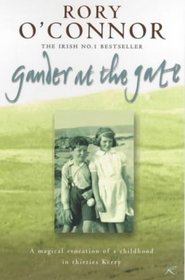Helpful Score: 2
From the back cover: Knocknagoshel, north Kerry, in the 1930s. Autumn mornings with mist rolling over a 'kindly and fertile land'; the pungent smoke of turf fires; open-air wrestling contests; convoys of tinkers with their piebald ponies; farm boys and servant girls aching with desire; and a cast of remarkable men and even more remarkable women, fiery and forthright, their lives 'teeming with the emotions of love and jealousy, and human conflict, common among all the simple people of the world'.
Through the lyrical prose of Rory O'Connor, Gander at the Gate tells of an Irish farmhouse, the family who lived there, and the community of which they were part. We discover the imaginings and adventures of the local 'goboys'; the widow Delia and her sons lost to America; and the eccentric Uncle Jack, full of 'riddles, and recitations, and the latest rhymes and small poems'. As the gander of the title - the fiercest beast of the farmyard - begins to intrude on his consciousness, O'Connor describes his youthful wonders and apprehensions - and the darker shadows cast by his father's experience of Ireland's civil war.
Through the lyrical prose of Rory O'Connor, Gander at the Gate tells of an Irish farmhouse, the family who lived there, and the community of which they were part. We discover the imaginings and adventures of the local 'goboys'; the widow Delia and her sons lost to America; and the eccentric Uncle Jack, full of 'riddles, and recitations, and the latest rhymes and small poems'. As the gander of the title - the fiercest beast of the farmyard - begins to intrude on his consciousness, O'Connor describes his youthful wonders and apprehensions - and the darker shadows cast by his father's experience of Ireland's civil war.





